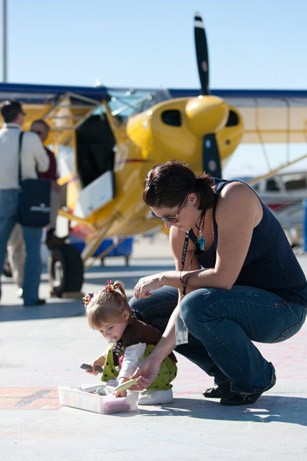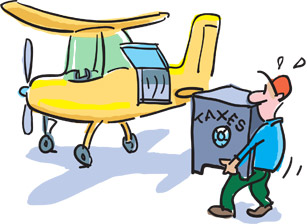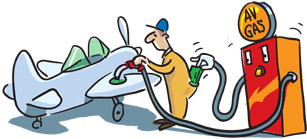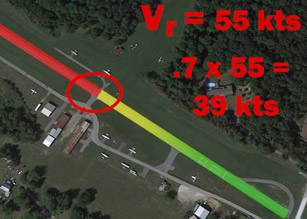News and Notes: New one-day events
AOPA sets dates and locationsfor grassroots events
 AOPA will hold six events throughout the year in lieu of its annual aviation Summit, which was suspended last fall. These regional events will allow the association to “meet its members where they are,” said AOPA President Mark Baker (see “Briefing: AOPA Announces Fly-In Locations and Dates,” page 32). The 2014 sites and dates for the six fly-in events have been selected. They are: San Marcos Municipal Airport (HYI), San Marcos, Texas, April 26; Indianapolis Regional Airport (MQJ), Indianapolis, Indiana, May 31; Plymouth Municipal Airport (PYM), Plymouth, Massachusetts, July 12; Felts Field (SFF), Spokane, Washington, August 16; Chino Airport (CNO), Chino, California, September 20; and Malcolm McKinnon Airport (SSI), on St. Simons Island in Brunswick, Georgia, November 8.
AOPA will hold six events throughout the year in lieu of its annual aviation Summit, which was suspended last fall. These regional events will allow the association to “meet its members where they are,” said AOPA President Mark Baker (see “Briefing: AOPA Announces Fly-In Locations and Dates,” page 32). The 2014 sites and dates for the six fly-in events have been selected. They are: San Marcos Municipal Airport (HYI), San Marcos, Texas, April 26; Indianapolis Regional Airport (MQJ), Indianapolis, Indiana, May 31; Plymouth Municipal Airport (PYM), Plymouth, Massachusetts, July 12; Felts Field (SFF), Spokane, Washington, August 16; Chino Airport (CNO), Chino, California, September 20; and Malcolm McKinnon Airport (SSI), on St. Simons Island in Brunswick, Georgia, November 8.
AOPA homecoming
AOPA also is bringing back its fly-in at Frederick Municipal Airport (FDK). Fly in or drive in for “AOPA Homecoming” on October 4, 2014. Come “home” and take part in a great party, which also celebrates 75 years of preserving general aviation.
On the Web: www.aopa.org/fly-ins
What AOPA is doing to keep you flying
FAA releases roadmap for UAS integration
The FAA released its long-awaited Unmanned Aerial Systems (UAS) road map, the first step in integrating unmanned aircraft into the National Airspace System. While the road map, which was mandated by the FAA Modernization and Reform Act of 2012, marks an important milestone, full integration of UAS is still years away. The road map addresses the need for regulations, policies, procedures, guidance, and training to support routine UAS operations, stressing that the system for managing UAS will continue to evolve along with the rest of the National Airspace System. It also paves the way for the FAA to select six congressionally mandated UAS test sites where the practical work of integrating UAS into the airspace system will begin.
“It’s critical that unmanned aircraft integrate with the existing aviation system. They need to be able to operate safely in the same airspace used by manned flights,” said AOPA Vice President of Government Affairs Melissa Rudinger, who represents AOPA on the UAS Aviation Rulemaking Committee. “We have insisted that UAS be certified with a standard airworthiness certificate, be flown by a certified pilot, and be flown in compliance with current operating rules and airspace requirements.”
Small airPlane Revitalization Act signed
President Barack Obama signed into law the Small Airplane Revitalization Act (SARA), a bill that requires the FAA to adopt new certification regulations that should reduce the cost of aircraft and avionics upgrades. SARA gives the FAA until December 15, 2015, to adopt changes to FAR Part 23. Manufacturers say that a streamlined Part 23 will reduce certification costs and thus the price of new aircraft. The changes also should reduce the certification cost and price of modifications of all types, from avionics to airbags and seats to restraints, making it more affordable for owners to install modern safety equipment in older aircraft.
“Passage of the Small Airplane Revitalization Act is great news for the general aviation community,” said AOPA President Mark Baker. “Reforming the way the FAA certifies aircraft can help more pilots fly more safely while lowering their costs—and that’s exactly the kind of support general aviation needs to thrive.”
Action in the states
Wisconsin is latest state to take up GA maintenance tax cut
 Legislation to eliminate the sales tax on aircraft parts and labor has been on the move in Wisconsin, as AOPA, EAA, and local allies made a push just prior to the legislature’s adjournment for the year. The measure, Assembly Bill 438, will now carry over to the January session with the 2013 progress intact. AOPA Government Affairs’ Mark Kimberling and Bryan Budds both appeared before two committees, and met with other key legislators in Madison, explaining that the bill would be essential to save the state’s network of aviation businesses and employment in an increasingly competitive region. Nearby Indiana was the most recent state to enact a sales tax exemption for aircraft maintenance and fuel, putting additional pressure on Wisconsin to take action. Wisconsin Senate President Michael Ellis is spearheading the effort within the legislature and called for a full Senate vote in early 2014.
Legislation to eliminate the sales tax on aircraft parts and labor has been on the move in Wisconsin, as AOPA, EAA, and local allies made a push just prior to the legislature’s adjournment for the year. The measure, Assembly Bill 438, will now carry over to the January session with the 2013 progress intact. AOPA Government Affairs’ Mark Kimberling and Bryan Budds both appeared before two committees, and met with other key legislators in Madison, explaining that the bill would be essential to save the state’s network of aviation businesses and employment in an increasingly competitive region. Nearby Indiana was the most recent state to enact a sales tax exemption for aircraft maintenance and fuel, putting additional pressure on Wisconsin to take action. Wisconsin Senate President Michael Ellis is spearheading the effort within the legislature and called for a full Senate vote in early 2014.
“We’re pleased to have Senator Ellis energized about this vital reform,” said Kimberling. “He understands how vital it is to Wisconsin’s aviation community.” The state’s high taxes currently are so noncompetitive, that many Wisconsin-based aircraft operators bypass local shops and leave the state for major repairs—taking revenue and jobs with them.
Wisconsin senate passes private airfield liability bill
The Wisconsin senate recently approved a measure to provide liability protection for owners of private airfields used for recreational purposes. Senate Bill 321 would add recreational aviation to Wisconsin’s existing recreational-use statute, clearing the path for these owners to open more airfields for public use. “With this measure, the Wisconsin legislature would equitably provide the same level of liability protection afforded to skiers, ATVers, hikers, and others to the aviation industry while operating on privately owned land,” said AOPA Great Lakes Regional Manager Bryan Budds.
Next up in the Michigan fuel tax saga: Cut and dedicate
 After several years of struggling with the legislature over multiple fuel tax increase proposals—and efforts to secure a share of existing tax revenue for airport investments—AOPA, the Michigan Association of Airport Executives, and the Michigan Business Aviation Association are working cooperatively with the Michigan legislature on comprehensive transportation reform that would address both the tax rate and revenue dedication for years to come. The Michigan House recently passed a trio of bills (House bills 4571, 4572, and 4677) that would reduce the state’s current uncompetitive combined sales and excise fuel tax rates—one of the highest in the nation—with a sales tax cut and excise tax elimination. Although the legislature has adjourned for the year, all three bills will carry over to next session, and AOPA will now focus on Senate passage. “Unfortunately, Michigan currently has the worst of both worlds in regard to the tax and revenue situation,” said AOPA Regional Manager Bryan Budds. “Pilots are paying more than their fair share of taxes, with little to no return on the investment in terms of revenue dedication for airport improvements. But now, with this new legislative package, AOPA is fully supportive of a comprehensive, long-term solution to fix this problem once and for all.”
After several years of struggling with the legislature over multiple fuel tax increase proposals—and efforts to secure a share of existing tax revenue for airport investments—AOPA, the Michigan Association of Airport Executives, and the Michigan Business Aviation Association are working cooperatively with the Michigan legislature on comprehensive transportation reform that would address both the tax rate and revenue dedication for years to come. The Michigan House recently passed a trio of bills (House bills 4571, 4572, and 4677) that would reduce the state’s current uncompetitive combined sales and excise fuel tax rates—one of the highest in the nation—with a sales tax cut and excise tax elimination. Although the legislature has adjourned for the year, all three bills will carry over to next session, and AOPA will now focus on Senate passage. “Unfortunately, Michigan currently has the worst of both worlds in regard to the tax and revenue situation,” said AOPA Regional Manager Bryan Budds. “Pilots are paying more than their fair share of taxes, with little to no return on the investment in terms of revenue dedication for airport improvements. But now, with this new legislative package, AOPA is fully supportive of a comprehensive, long-term solution to fix this problem once and for all.”
Advocate pilot = Great ASN volunteer
When Vancouver, Washington’s longstanding Airport Support Network volunteer at Pearson Field (VUO) was ready to step down from his role, Paul Speer was ready to step into his place.
Speer serves as the chair of the Pearson Field Aviation Advisory Commission to the City of Vancouver and has been a constant advocate for VUO on issues such as the battle to protect Pearson’s airspace and the struggle over the Pearson Air Museum. Speer already was engaged at a level that allows him to understand the political nuances that affect the airport, and was already actively promoting the field.
When Pearson Field hosted its annual celebration last fall featuring Disney’s Planes, Speer made sure AOPA was there to greet the more than 400 visitors, with brochures and information for airport neighbors and young people. Speer makes a point of meeting with stakeholders at Pearson, as well as other visitors coming to the field, even arranging tours for out-of-town visitors. He has also been quick to share information with pilots at the airport, responding quickly to members on issues of concern at the facility.
What’s next for your airport? Would you have the knowledge and time to help preserve your field?
Web: www.aopa.org/ASN
AOPA Foundation: Rusty on interpreting instrument approach procedures?
Shake it off with ASI's IFR safety quizzes
 If you’re looking for a fun and quick way to test your instrument procedures knowledge, then take a moment and hone your skills with an Air Safety Institute IFR safety quiz. From The Hokie Approach to Flying Rogue to A Visit to the Grey Lady, you’ll be challenged with some unusual if not unique instrument approach procedures.
If you’re looking for a fun and quick way to test your instrument procedures knowledge, then take a moment and hone your skills with an Air Safety Institute IFR safety quiz. From The Hokie Approach to Flying Rogue to A Visit to the Grey Lady, you’ll be challenged with some unusual if not unique instrument approach procedures.
For example, you’ll be tested on flying the LOC/DME BC-B approach into Rogue Valley International Airport in Oregon, which is surrounded by hills as tall as 9,500 feet. Grab the opportunity to guide your Cessna 182 into foggy Nantucket, Massachusetts. And you’ll be expected to find the runway in IMC while executing ILS, LDA, and VOR approaches at the various airports included in the IFR safety quiz lineup. The quizzes have been recently optimized for the iPad so you can take them anywhere your tablet goes (www.airsafetyinstitute.org/safetyquizzes).
You need to correctly answer 80 percent, or eight out of 10 questions, to pass a quiz. And with a passing score you also qualify for AOPA Accident Forgiveness credit.
Are your takeoffs as good as your landings?
View the Air Safety Institute's new 'Takeoffs and Landings' video series
 How sharp are your crosswind and short-field landing skills? A new video series, made possible by the Canadian Owners and Pilots Association and the Donner Canadian Foundation, unveils the finer points of practicing and honing your takeoff and landing technique beyond currency requirements. The first installment in the series, Takeoffs and Landings: Determining an Abort Point, helps pilots learn how to choose an abort point if your takeoff roll isn’t going as planned. Also view the next three video segments—on short-field landings, normal takeoffs, and crosswind landings—to understand simple rules of thumb we all can live by.
How sharp are your crosswind and short-field landing skills? A new video series, made possible by the Canadian Owners and Pilots Association and the Donner Canadian Foundation, unveils the finer points of practicing and honing your takeoff and landing technique beyond currency requirements. The first installment in the series, Takeoffs and Landings: Determining an Abort Point, helps pilots learn how to choose an abort point if your takeoff roll isn’t going as planned. Also view the next three video segments—on short-field landings, normal takeoffs, and crosswind landings—to understand simple rules of thumb we all can live by.
Visit the website for dates and locations near you.
Educating pilots on improving their skills and enhancing GA safety is a core tenet of the AOPA Foundation’s Air Safety Institute and its educational programs. Your contribution funds these activities and ensures that ASI continues to address the needs of pilots everywhere. Show your support today.
Member Services: Market recovery?
AOPA Aviation Finance can help
Many aircraft owners were shocked by the economic events of 2008 and 2009. Not only were aircraft owners’ personal finances rocked but because of some “dump and run” tactics by banks and unprepared aircraft owners, values of many aircraft declined by up to 40 percent almost overnight.
At the same time, a number of banks and financial institutions withdrew from aviation lending to concentrate on other troubled loans, especially real estate. Some aircraft owners may have received communications from their lenders that additional amortization was required on their loan or that a balloon payment would not be refinanced.
The decreased availability of easy aircraft financing resulted in many potential buyers seeking other financing sources—including home equity, business loans, and cash—to fund aircraft purchases. In 2008 approximately 80 percent of aircraft purchases were financed, compared to just 20 percent currently.
Fortunately, the market is recovering and banks are loosening requirements on aircraft loans and reintroducing financing products. If you have been discouraged in the past couple of years with available options for an aircraft purchase, it may benefit you to contact your lending institution to find out what options you have in the current market conditions.
To help members make sense of these changing market conditions, the AOPA Aviation Finance Company, LLC (AAF) was formed in early 2013. AAF sought out lenders that are committed to aviation finance, have attractive rates and terms and know how to service AOPA member needs. This newly formed syndicate of lenders is now ready to assist AOPA members. Interest rates have dropped and values of many aircraft have stabilized, so now may be the right time for aircraft owners to consider refinancing or changing aircraft.
AOPA Aviation Finance has a staff of knowledgeable specialists to help find solutions for your lending needs and answer all your aviation financing questions. Call 800-62-PLANE (75263) to speak with a specialist.
Answers for pilots
Flying to mexico
Sparkling blue waters, warm sunshine, whale watching—we’re talking about the west coast of Mexico in winter! If flying to Mexico is on your bucket list, find out how to prepare for the trip in February’s Answers for Pilots.
AOPA Strategic Partner Spotlight: Aero-Space Reports
 Aero-Space Reports offers members-only discounts on aircraft title search packages ($65 savings) and escrow transactions (10 percent); provides sponsorship of AOPA events, and the aircraft valuation section of aopa.org, and provides financial support that helps AOPA promote, protect, and defend GA (www.aopa.org/title).
Aero-Space Reports offers members-only discounts on aircraft title search packages ($65 savings) and escrow transactions (10 percent); provides sponsorship of AOPA events, and the aircraft valuation section of aopa.org, and provides financial support that helps AOPA promote, protect, and defend GA (www.aopa.org/title).
Insurance Services: Liability versus liability
When insurance tests really important
 Everyone is familiar with the terms liability insurance and life insurance, but just how do those terms apply when there is a loss?
Everyone is familiar with the terms liability insurance and life insurance, but just how do those terms apply when there is a loss?
You and your bank president passenger are day VFR over the Shenandoah Valley of Virginia, when your engine swallows a valve. You respond with the well-practiced skill of a professional aviator and put your airplane down in a hayfield with nary a scratch. Great. Under such circumstance neither bodily injury liability nor life insurance should come into play, but what if it had been dark or if you had been 50 miles further west? If so, you might well have been dealing with issues of liability and life insurance.
If, as the aircraft owner, you carried liability insurance of $1 million each occurrence with a $200,000 per passenger sublimit, and your bank president passenger was injured or killed, your insurance company could either defend you, try to settle the claim of the injured passenger up to $200,000, or do a combination of both. This protection is premised on the idea that the pilot was legally liable for the injury, and that the insurance company was responding to that claim. Are you sure you checked that oil? Had there been “issues” with that valve before? Remember, it could be up to the courts to determine if there was negligence.
So what if you are injured or killed? If your policy provides “Medical payments, including crew,” you might receive a small payment (usually $5,000), but unless you carry life insurance or accidental death and dismemberment (AD&D) that does not have a general aviation aircraft, pilot, or crew exclusion, you would likely receive nothing. Some life insurance companies allow you to pay a premium to remove this exclusion, others will not. Be sure to check your policy. Your AOPA life insurance program has no aviation exclusions, and coverage is available for up to $1 million. AOPA members also can add up to $300,000 of AD&D insurance regardless of pilot experience, and can add dependent family coverage for your spouse or unmarried children under age 25. If you are currently enrolled in the AOPA AD&D plan and would like to change your plan, increase your benefit amount, or have questions, call AOPA Insurance Services at 877-432-AOPA (2672).
Bill Snead was named president of the AOPA Insurance Agency in 2013.
